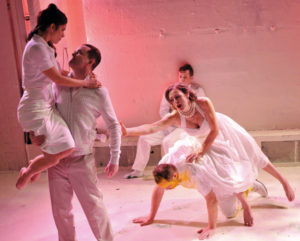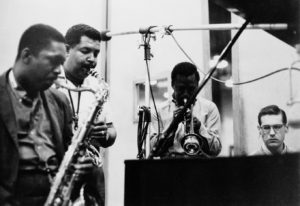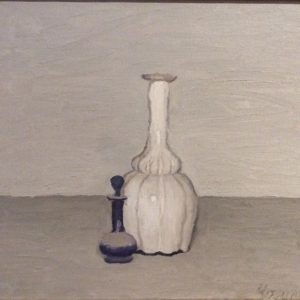Here’s my list of recommended Broadway, off-Broadway, and out-of-town shows, updated weekly. In all cases, I gave these shows favorable reviews (if sometimes qualifiedly so) in The Wall Street Journal when they opened. For more information, click on the title.
BROADWAY:
• An American in Paris (musical, G, too complex for small children, reviewed here)
• The Color Purple (musical, PG-13, reviewed here)
• Eclipsed (drama, PG-13, Broadway remounting of off-Broadway production, closes June 19, original production reviewed here)
• Fully Committed (comedy, PG-13, extended through July 31, reviewed here)
• Fun Home (serious musical, PG-13, some performances sold out last week, reviewed here)
• Hamilton (musical, PG-13, Broadway transfer of off-Broadway production, all performances sold out last week, reviewed here)
• Matilda (musical, G, closing Jan. 1, most performances sold out last week, reviewed here)
• Les Misérables (musical, G, too long and complicated for young children, closes Sept. 4, reviewed here)
• On Your Feet! (jukebox musical, G, reviewed here)
• She Loves Me (musical, G, suitable for bright children capable of enjoying a love story, nearly all performances sold out last week, closes July 10, reviewed here)
OFF BROADWAY:
• The Fantasticks (musical, G, suitable for children capable of enjoying a love story, reviewed here)
 IN CAMBRIDGE, MASS.:
IN CAMBRIDGE, MASS.:
• Twelfth Night (Shakespeare, PG-13, two different stagings of the same play performed by the same cast in rotating repertory, closes July 10, original production reviewed here)
CLOSING SOON ON BROADWAY:
• The King and I (musical, G, perfect for children with well-developed attention spans, closes June 26, reviewed here)
CLOSING NEXT WEEK IN HOUSTON:
• Saint Joan (drama, PG-13, remounting of off-Broadway production, closes June 18, original production reviewed here)
CLOSING SUNDAY IN BALTIMORE:
• Death of a Salesman (drama, PG-13, reviewed here)
• A Streetcar Named Desire (drama, PG-13, reviewed here)
CLOSING SUNDAY IN BROOKLYN:
• The Judas Kiss (drama, R, reviewed here)
CLOSING SUNDAY IN CHICAGO:
• Tug of War: Foreign Fire (Shakespeare, PG-13, six-hour marathon staging of Edward III, Henry V, and Henry VI, Part One, reviewed here)


 It works both ways, of course. Most things do—which is my point. I tweeted the other day that if I owned a time machine, I’d set it to 1959, and a minute or so later I heard from a stranger who was under the mistaken impression that I needed to be reminded that things weren’t so hot for blacks and women back then. Shame on me, in other words, for daring to suppose that America in 1959—the year in which, among other noteworthy things, Miles Davis recorded Kind of Blue and Lorraine Hansberry’s A Raisin in the Sun opened on Broadway—was something other than a stinking cesspool of pure, unmitigated hate.
It works both ways, of course. Most things do—which is my point. I tweeted the other day that if I owned a time machine, I’d set it to 1959, and a minute or so later I heard from a stranger who was under the mistaken impression that I needed to be reminded that things weren’t so hot for blacks and women back then. Shame on me, in other words, for daring to suppose that America in 1959—the year in which, among other noteworthy things, Miles Davis recorded Kind of Blue and Lorraine Hansberry’s A Raisin in the Sun opened on Broadway—was something other than a stinking cesspool of pure, unmitigated hate. This surprised me, for I had vivid childhood memories of enjoying Dana’s TV appearances, though the only specific thing I could remember about them was his invariable opening line, “My name…José Jiménez,” which he delivered in a foot-thick south-of-the-border accent. Since Dana was a regular on variety shows well into the Seventies, I figured I wouldn’t have any trouble tracking down one of his routines on YouTube, so I went there and spent a few minutes refreshing my memory. I, too, was startled by the unthinking racism of Dana’s old-fashioned style of comedy, and said so in my reply. “Kind of amazing how it makes Amos & Andy seem sort of mild by comparison,” another follower added.
This surprised me, for I had vivid childhood memories of enjoying Dana’s TV appearances, though the only specific thing I could remember about them was his invariable opening line, “My name…José Jiménez,” which he delivered in a foot-thick south-of-the-border accent. Since Dana was a regular on variety shows well into the Seventies, I figured I wouldn’t have any trouble tracking down one of his routines on YouTube, so I went there and spent a few minutes refreshing my memory. I, too, was startled by the unthinking racism of Dana’s old-fashioned style of comedy, and said so in my reply. “Kind of amazing how it makes Amos & Andy seem sort of mild by comparison,” another follower added. Which brings us right back to where we started. Those who think that human life is anything other than a fearfully complicated and ambiguous affair are kidding themselves. If you’re a regular reader of this blog, you know that I have powerful feelings of nostalgia and love for the simpler, quieter world of my small-town childhood—but you also know that the last American lynching to take place outside the Deep South
Which brings us right back to where we started. Those who think that human life is anything other than a fearfully complicated and ambiguous affair are kidding themselves. If you’re a regular reader of this blog, you know that I have powerful feelings of nostalgia and love for the simpler, quieter world of my small-town childhood—but you also know that the last American lynching to take place outside the Deep South 

 On Saturday afternoon I went directly from Penn Station to New York’s Center for Italian Modern Art to see an exhibition of some forty-odd paintings and works on paper by Giorgio Morandi. His work has long had special meaning for me, so much so that I once went so far as to
On Saturday afternoon I went directly from Penn Station to New York’s Center for Italian Modern Art to see an exhibition of some forty-odd paintings and works on paper by Giorgio Morandi. His work has long had special meaning for me, so much so that I once went so far as to  Four years later the Metropolitan Museum of Art finally mounted a large-scale retrospective, to which I went twice. But the very idea of a blockbuster show devoted to an artist like Morandi, as I
Four years later the Metropolitan Museum of Art finally mounted a large-scale retrospective, to which I went twice. But the very idea of a blockbuster show devoted to an artist like Morandi, as I  Not so the show at the Center for Italian Modern Art. While it is, to be sure, comparatively large—this is only the third time in my life that I’ve seen more than a half-dozen Morandis in one place—CIMA is presenting the paintings in a way infinitely better suited to their intimate essence. In order to see them, you must make an appointment to tour the center, which is located in lower Manhattan. When you arrive, you first sit down in the kitchen with your fellow visitors and drink an excellent cup of espresso made by the staff. Then one of CIMA’s resident scholars (ours was Nicola Lucchi) walks you through the show, talking very intelligently about the artist and his work. Once the tour is finished, you’re free to wander at will through the three rooms where the paintings are hung. These rooms are all furnished in such a way as to suggest a private home, with plenty of couches and chairs on which you can sit, look, and reflect for as long as you like.
Not so the show at the Center for Italian Modern Art. While it is, to be sure, comparatively large—this is only the third time in my life that I’ve seen more than a half-dozen Morandis in one place—CIMA is presenting the paintings in a way infinitely better suited to their intimate essence. In order to see them, you must make an appointment to tour the center, which is located in lower Manhattan. When you arrive, you first sit down in the kitchen with your fellow visitors and drink an excellent cup of espresso made by the staff. Then one of CIMA’s resident scholars (ours was Nicola Lucchi) walks you through the show, talking very intelligently about the artist and his work. Once the tour is finished, you’re free to wander at will through the three rooms where the paintings are hung. These rooms are all furnished in such a way as to suggest a private home, with plenty of couches and chairs on which you can sit, look, and reflect for as long as you like. Having collected art for more than a decade, I know what a priceless privilege it is to be able to look at paintings in a domestic setting. But if, in addition, you must make your home in a noisy city like New York, then it is not merely a privilege but a necessity to retreat at regular intervals from the hum and buzz of urban life and commune with the work of an artist who, like Morandi, has the power to fill the soul with silence. In the absence of such silences—and such art—there can be no thought, no imagination, no respite from the unceasing flow of words, most of them pointless, that blunts our capacity to think and feel.
Having collected art for more than a decade, I know what a priceless privilege it is to be able to look at paintings in a domestic setting. But if, in addition, you must make your home in a noisy city like New York, then it is not merely a privilege but a necessity to retreat at regular intervals from the hum and buzz of urban life and commune with the work of an artist who, like Morandi, has the power to fill the soul with silence. In the absence of such silences—and such art—there can be no thought, no imagination, no respite from the unceasing flow of words, most of them pointless, that blunts our capacity to think and feel.